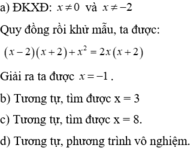b) 11x − 3x = 60 + 2x

Những câu hỏi liên quan
Bài 4: Tìm x biết:
a) 2x + x = 45 .
b) 2x + 7x = 918 .
c) 2x + 3x = 60 + 5.
d) 11x + 22x = 33.2 .
a) ( 2 + 1 )x = 45
3x = 45
x = 45 : 3
x = 15
b) ( 2 + 7 )x = 918
9x = 918
x = 918 : 9
x = 102
c) ( 2 + 3 )x = 65
5x = 65
x = 65 : 5
x = 13
d) ( 11 + 22 )x = 66
33 x = 66
x = 66 : 33
x = 2
a, 2x+x=45
2x+x.1=45
(2+1)x=45
3x =45
x =45:3
x = 15
Vậy...
Phần b xíu chirsau đc ko
a) 2x+x=45
3x =45
x =45:3
x =15
vậy...
b) 2x+7x=918
9x =918
x =918:9
x =102
vậy...
c) 2x+3x=60+5
5x =65
x =65:5
x =13
vậy...
d)11x+22x=33.2
33x =66
x =66:33
x =22
vậy...
cộng phân thức đại số :
( 3 - 3x ) / 2x + ( 3x - 1 ) / ( 2x - 1 ) + ( 11x - 5 ) / ( 2x - 4x2)
\(\dfrac{3-3x}{2x}+\dfrac{3x-1}{2x-1}+\dfrac{11x-5}{2x-4x^2}\\ =\dfrac{\left(3-3x\right)\left(1-2x\right)}{2x\left(1-2x\right)}-\dfrac{2x\left(3x-1\right)}{2x\left(1-2x\right)}+\dfrac{11x-5}{2x\left(1-2x\right)}\\ =\dfrac{3-9x+6x^2}{2x\left(1-2x\right)}-\dfrac{6x^2-2x}{2x\left(1-2x\right)}+\dfrac{11x-5}{2x\left(1-2x\right)}\\ =\dfrac{3-9x+6x^2-6x^2+2x+11x-5}{2x\left(1-2x\right)}\\ =\dfrac{-2}{2x\left(1-2x\right)}\\ =\dfrac{-1}{x\left(1-2x\right)}\)
Đúng 7
Bình luận (0)
giải phương trình a)2x-7=11x+11
b)2011x-4=x+6
c)5(2x-3)-2(3x-5)=0
a) 2x-7=11x+11
<=> 2x-11x=11+7
<=> -9x=17
<=> x= -17/9
b) 2011x -4 =x+6
<=> 2011x-x=6+4
<=> 2010x=10
<=> x=10/2010
<=> x=1/201
c) 5(2x-3)-2(3x-5)=0
<=> 10x-15-6x+10=0
<=> 10x-6x=15-10
<=>4x=5
<=> x=5/4
Đúng 0
Bình luận (0)
Tìm GTNN
a) A= 4x^2+11x-2
b) B= 3x^2-2x-1
Tìm GTLN
a) A = -x^2+3x-1
b) B = -x^2-4x+7
a)A=4(x+11/8)^2 -153/16
Min A=-153/16 khi x=-11/8
b)B=3(x-1/3)^2 -4/3
Min B=-4/3 khi x=1/3
Đúng 1
Bình luận (0)
Bài 1:
a) \(A=4x^2+11x-2=\left(4x^2+11x+\dfrac{121}{16}\right)-\dfrac{153}{16}=\left(2x+\dfrac{11}{4}\right)^2-\dfrac{153}{16}\ge-\dfrac{153}{16}\)
\(minA=-\dfrac{153}{16}\Leftrightarrow x=-\dfrac{11}{8}\)
b) \(B=3x^2-2x-1=3\left(x^2-\dfrac{2}{3}x+\dfrac{1}{9}\right)-\dfrac{4}{3}=3\left(x-\dfrac{1}{3}\right)^2-\dfrac{4}{3}\ge-\dfrac{4}{3}\)
\(minB=-\dfrac{4}{3}\Leftrightarrow x=\dfrac{1}{3}\)
Bài 2:
a) \(A=-x^2+3x-1=-\left(x^2-3x+\dfrac{9}{4}\right)+\dfrac{5}{4}=-\left(x-\dfrac{3}{2}\right)^2+\dfrac{5}{4}\le\dfrac{5}{4}\)
\(maxA=\dfrac{5}{4}\Leftrightarrow x=\dfrac{3}{2}\)
b) \(B=-x^2-4x+7=-\left(x^2+4x+4\right)+11=-\left(x+2\right)^2+11\le11\)
\(maxB=11\Leftrightarrow x=-2\)
Đúng 1
Bình luận (2)
Bài 1:
a: Ta có: \(A=4x^2+11x-2\)
\(=4\left(x^2+\dfrac{11}{4}x-\dfrac{1}{2}\right)\)
\(=4\left(x^2+2\cdot x\cdot\dfrac{11}{8}+\dfrac{121}{64}-\dfrac{153}{64}\right)\)
\(=4\left(x+\dfrac{11}{8}\right)^2-\dfrac{153}{16}\ge-\dfrac{153}{16}\forall x\)
Dấu '=' xảy ra khi \(x=-\dfrac{11}{8}\)
b: Ta có: \(B=3x^2-2x-1\)
\(=3\left(x^2-\dfrac{2}{3}x-\dfrac{1}{3}\right)\)
\(=3\left(x^2-2\cdot x\cdot\dfrac{1}{3}+\dfrac{1}{9}-\dfrac{4}{9}\right)\)
\(=3\left(x-\dfrac{1}{3}\right)^2-\dfrac{4}{3}\ge-\dfrac{4}{3}\forall x\)
Dấu '=' xảy ra khi \(x=\dfrac{1}{3}\)
Đúng 0
Bình luận (0)
Xem thêm câu trả lời
Giải các phương trình sau:a)
x
−
2
x
+
x
x
+
2
2
;
b)
2
x
+
1
−
1
x
−
2
3...
Đọc tiếp
Giải các phương trình sau:
a) x − 2 x + x x + 2 = 2 ;
b) 2 x + 1 − 1 x − 2 = 3 x − 11 x + 1 x − 2 ;
c) 5 + 96 x 2 − 16 = 2 x − 1 x + 4 + 3 x − 1 x − 4 ;
d) 2 x + 2 − 2 x 2 + 16 x 3 + 8 = 5 x 2 − 2 x + 4 .
a) 2x-x^3+4y-8y^3
b) -3x^2+11x+14
a) 2x - x3 + 4y - 8y3
= ( 2x + 4y ) - ( x3 + 8y3 )
= 2( x + 2y ) - ( x + 2y )( x2 - 2xy + 4y2 )
= ( x + 2y )( 2 - x2 + 2xy - 4y2 )
b) -3x2 + 11x + 14
= -3x2 + 14x - 3x + 14
= -x( 3x - 14 ) - ( 3x - 14 )
= ( 3x - 14 )( -x - 1 )
Bài:Chia 1 biến đã sắp xếp 1)(2x^3+11x^2+18x-3):(2x+3) 2)(2x^3+11x^2+18x-3):(3x+3) 3)(2x^3+9x^2+5x+41):(2x^2-x+9) 4)(13x+41x^2+35x^3-14):(5x-2) 5)(5x^2-3x^3+15-9x):(5-3x) 6)(-4x^2+x^3-20+5x):(x-4)
1: \(\dfrac{2x^3+11x^2+18x-3}{2x+3}\)
\(=\dfrac{2x^3+3x^2+8x^2+12x+6x+9-12}{2x+3}\)
\(=x^2+4x+3-\dfrac{12}{2x+3}\)
Đúng 0
Bình luận (0)
A:(2x+3)^3=(2x+3)^8
B: (6-2x)^9=(6-2x)^31
C:|5-3x|=|11x+2|
a) \(\left(2x+3\right)^3=\left(2x+3\right)^8\)
\(\left(2x+3\right)^8-\left(2x+3\right)^3=0\)
\(\left(2x+3\right)^3.\text{ }\left[\left(2x+3\right)^5-1\right]=0\)
\(\Rightarrow\orbr{\begin{cases}\left(2x+3\right)^3=0\\\left(2x+3\right)^5-1=0\end{cases}\Leftrightarrow\orbr{\begin{cases}2x+3=0\\\left(2x+3\right)^5=1\end{cases}\Leftrightarrow}\orbr{\begin{cases}x=-\frac{3}{2}\\x=-1\end{cases}}}\)
Vậy \(x=-\frac{3}{2}\) hoặc \(x=-1\)
Câu b tương tự
c) \(\left|5-3x\right|=\left|11x+2\right|\)
\(\Rightarrow\orbr{\begin{cases}5-3x=11x+2\\5-3x=-11x-2\end{cases}\Leftrightarrow\orbr{\begin{cases}11x+3x=2-5\\-3x+11x=-2+5\end{cases}\Leftrightarrow\orbr{\begin{cases}14x=-3\\8x=3\end{cases}\Leftrightarrow}\orbr{\begin{cases}x=-\frac{3}{14}\\x=\frac{3}{8}\end{cases}}}}\)
Vậy \(x=-\frac{3}{14}\)hoặc \(x=\frac{8}{3}\)
Đúng 0
Bình luận (0)
Cho biểu thức :
A
15
x
-
11
x
+
2
x
-
3
+
3
x
-
2
1
-
x
-
3
x
+...
Đọc tiếp
Cho biểu thức :
A = 15 x - 11 x + 2 x - 3 + 3 x - 2 1 - x - 3 x + 3 x ≥ 0 ; x ≠ 1
b) Tìm x nguyên để A nguyên.
b) Tìm x nguyên để A nguyên

⇔ x + 3 ∈ Ư(11) ⇔ x + 3 ∈ {-11; -1; 1; 11}
Do x + 3 ≥ 3 nên x + 3 = 11 ⇔ x = 8 ⇔ x = 64
Vậy với x = 64 thì A nguyên
Đúng 0
Bình luận (0)


























